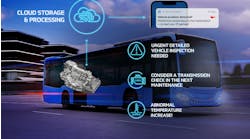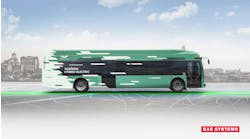Electrifying our future: The power of partnerships in transit's green revolution
Across the U.S., transit agencies are replacing their rumbling diesel fleets with silent electric vehicles, demonstrating that large-scale transportation electrification isn't just an environmental aspiration—it's a practical reality. The momentum is undeniable: the number of full-size zero-emission buses on the road reached more than 7,000 as of July 2024, a 14 percent increase from 2023, while school districts with electric bus commitments have surged by 500 percent since 2021. Even the U.S.’s largest transit system, the Metropolitan Transportation Authority in New York City, has committed to converting its 5,800-plus municipal bus fleet to all-electric by 2040.
These agencies aren't merely reducing emissions; they're proving that zero-emissions mass transit can effectively serve our communities. Yet, this transformation extends beyond simply swapping vehicles. It's fueled by innovative public-private partnerships that tackle infrastructure challenges traditional transit systems never had to consider. These collaborations are creating blueprints for electrification that carefully balance ambitious state and city climate goals with the operational demands of serving our communities while also addressing critical electrical grid concerns. Their approach ensures that sustainability targets are met without compromising service reliability or overwhelming local power infrastructure.
Mastering the energy equation
The electrification journey begins with addressing a fundamental challenge—managing electricity demand and costs. Transit agencies suddenly find themselves navigating utility rate structures, grid capacity constraints and infrastructure planning that falls far outside their traditional expertise.
Through partnerships with utility providers, forward-thinking agencies are turning these challenges into opportunities, securing preferential electric utility rates, implementing smart demand management to avoid costly peak-hour charging and exploring vehicle-to-grid technologies that transform bus fleets into mobile power resources during emergencies.
These collaborations do more than make electrification financially viable; they strengthen community energy resilience while maintaining reliable transit service. Just as importantly, they provide a helpful reminder that local emission reductions can have real impacts – and quickly. For instance, electric school buses equipped with vehicle-to-grid (V2G) technology can charge during off-peak hours when electricity is cheaper and return power during peak times, benefiting both the grid and school budgets. Some utilities are even testing adaptable systems where V2G participants pay and get paid based on dynamic rates that reflect real-time grid conditions.
Reimagining infrastructure
The physical realities of charging infrastructure present equally significant hurdles. Bus depots designed for diesel vehicles can rarely accommodate the extensive electrical equipment needed for fleet charging. Safety requirements, space constraints and operational workflows must all be reconsidered to ensure charging systems support rather than hinder transit operations. According to BloombergNEF, the initial infrastructure costs are substantial, reflecting the scale of investment needed for widespread electrification.
This is where thoughtful infrastructure planning becomes critical. The difference between a successful transition and an operational nightmare often comes down to understanding how charging systems integrate with existing transit operations. BloombergNEF estimates a $242 billion charging infrastructure market opportunity between today and 2050, underscoring the importance of strategic investment in this sector. Operators must carefully balance the need for space with operational efficiency, especially in urban depots for public buses where land is often limited.
Camber helps CapMetro with zero-emissions transition
Camber’s expanded collaboration with Capital Metropolitan Transportation Authority (CapMetro) is helping the agency address the multifaceted challenges with zero-emissions technology. Through the collaboration, Camber is helping with infrastructure solutions designed for current needs and future growth.
Camber recently delivered 2.9 megawatts of power to CapMetro's primary bus depot in Austin, Texas, enabling simultaneous charging for up to 48 electric buses. This installation includes two 1440 kW Camber Charging Systems and 48 Camber Industrial Dispensers, supported by ongoing maintenance to ensure reliable operations. The partnership also extends to on-route charging solutions, which allow electric buses to charge while out running their routes.
Camber’s charger and energy management software, Camber Core, paired with the company’s remote diagnostic tools, help manage energy costs while lowering the total cost of ownership. Our charging systems are interoperable with different vehicles, allowing depots to support mixed fleets with varying charging demands and power requirements.
The path forward
For transit leaders considering electrification, the message is clear: success depends not just on purchasing electric buses, but on forming strategic partnerships that address the full spectrum of challenges and opportunities. By collaborating with utility providers, infrastructure experts and experienced private sector partners, agencies can develop approaches that are environmentally sustainable, financially sound and operationally excellent.
The future of public transit isn't just electric—it's collaborative, bringing together public vision and private expertise to transform how we power the journey ahead.

Brendan Harney | President, Camber
Brendan Harney is the president of Camber. He has spent nearly a decade deploying charging infrastructure for EV fleets, leading the development of North America’s largest commercial fleet charging network.



